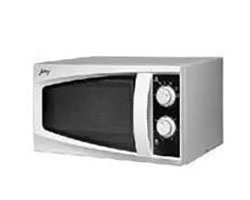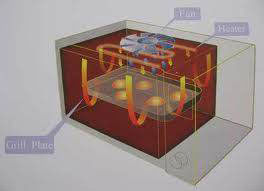A microwave oven, or simply a microwave, is a kitchen appliance that heats food by dielectric heating. This is achieved by using microwave radiation to heat polarized molecules within the food. This excitation is fairly uniform, leading to food being more evenly heated throughout (except in dense objects) when compared to what occurs in other cooking techniques.

Microwave oven
[Image source]
History
The heating effect of microwaves was discovered accidentally in 1945 by Percy Spencer, an American self-taught engineer from Howland, Maine, who was building magnetrons for radar sets with the American company Raytheon. He was working on an active radar set when he noticed that a peanut chocolate bar he had in his pocket started to melt. The radar had melted his chocolate bar with microwaves.
On October 8, 1945, Raytheon filed a US patent for Spencer's microwave cooking process and an oven that heated food using microwave energy was placed in a Boston restaurant for testing. In 1947, the company built the Radarange, the first commercial microwave oven in the world.
Through the 1960’s several companies developed different configurations of the microwave ovens and through Trade Shows began a rapid growth of the market for home microwave ovens. By the late 1970s the technology had improved to the point where prices were falling rapidly. Often called "electronic ovens" in the 1960s, the name "microwave ovens" later became standardized, often now referred to informally as simply "microwaves." Formerly found only in large industrial applications, microwave ovens were increasingly becoming a standard fixture of most kitchens. The rapidly falling price of microprocessors made it possible for adding electronic controls which made these ovens easier to use.
In India most of the modern microwave ovens are compact, well designed and provide a wide array of customizable cooking programmes to cook different kinds of dishes instantly. Microwave cooking not only helps one to save on electricity and oil but also gives food a richer aroma and more wholesome flavours.
Nowadays in India there are several well-known brands of microwave ovens like IFB, Samsung, LG, Godrej, etc. along with several local brands.
Principle of working
A microwave oven works by passing non-ionizing microwave radiation, usually at a frequency of 2.45 gigahertz (GHz)—a wavelength of 122 millimetres (4.80 in)—through the food. Microwave radiation is between common radio and infrared frequencies. Water, fat, and other substances in the food absorb energy from the microwaves in a process called dielectric heating. Many molecules (such as those of water) are electric dipoles, meaning that they have a positive charge at one end and a negative charge at the other, and therefore rotate as they try to align themselves with the alternating electric field of the microwaves. This molecular movement represents heat which is then dispersed as the rotating molecules hit other molecules and put them into motion.
Design
A microwave oven consists of:
• A high voltage power source, that is a simple transformer or an electronic power converter, which passes energy to the magnetron
• A high voltage capacitor is connected to the magnetron, transformer and via a diode to the case.
• A cavity magnetron, which converts high-voltage electric energy to microwave radiation
• A magnetron control circuit (usually with a microcontroller)
• A waveguide (to control the direction of the microwaves)
Nearly all modern microwave ovens have a control panel with an LED, liquid crystal or vacuum fluorescent display (early models used an analogue dial-type timer).
Numeric buttons for entering the cooking time, a button for selecting the power level (usually decrementing by 10 from 100 to 50, or using words such as High, Medium High and Medium) and a Defrost button are present in most microwaves ovens. Other buttons may be present which name the type of food to be cooked, such as meat, fish, poultry, vegetables, frozen vegetables, etc, which when pressed cook the item for a pre-programmed time.
The cooking chamber prevents the microwaves from escaping. All microwave energy remains inside the cooking cavity. When the door is opened, or the timer reaches zero, the microwave energy stops--just as turning off a light switch stops the glow of the lamp.
The oven door usually has a window for easy viewing, but the window has a layer of conductive mesh some distance from the outer panel to maintain the shielding. Because the size of the perforations in the mesh is much less than the microwaves' wavelength, most of the microwave radiation cannot pass through the door, while visible light (with a much shorter wavelength) can.
Types
There are three types of microwave ovens- convection, grill, and solo.
Convection- A convection microwave oven is a combination of a standard microwave and a convection oven. It allows food to be cooked quickly, yet come out browned or crisped, as from a convection oven. Convection microwaves are more expensive than standard microwave ovens. It uses a fan and a heating element to create airflow patterns inside the microwave oven. This ensures optimum browning of the food in the fastest possible times, making it an ideal choice for baking.
Apart from this, this type of oven has several additional features which are presented below.
It cooks the food in three ways (Triple Heating System), with a performance that's 23% faster than conventional single heating systems. The ceramic heater penetrates deep, while the outside is cooked by quartz heating.
The interiors are coated with ceramic enamel which is durable, as it will not scratch like stainless steel, or crack like plastic. And it's also easy to clean with just a damp cloth to wipe away all kinds of splatters. In addition, the walls are coated with an advanced material that acts as an anti-bacterial agent and deodoriser.
Some of the convection type microwave ovens have a Steam Clean System to clean the microwave oven. The Steam Clean container is filled with water and is placed close to the wall of the microwave oven. Then Steam Clean button is pressed. After a few moments, just one wipe is all it takes to eliminate bacteria and odours. This is a hygienic cleaning system that keeps the microwave oven clean and hygienic, without using detergents.
Grill - Grill microwave ovens can be used to cook food which is crispier from outside and juicer from inside making it an ideal choice for succulent Kebabs and Tikkas.

Grill type microwave oven
[Image source]
They too have a unique three way cooking system that is perfect if one wants to cook food that is crispier from the outside and juicier on the inside. They use the long wavelength system for cooking which allows heat to penetrate deep inside the food thus cooking the food well inside as well as outside. They help to achieve good browning and grilling for kebabs and tikkas like in the conventional ways of preparing these Indian items.
A conventional wave distribution system distributes microwaves from a single aperture antenna. This antenna has a high efficiency but low distribution capacity. In this case, microwaves are concentrated to a particular section of the food. To overcome this problem of uneven distribution of heating TDS (Triple distribution system) cooks every part of the food evenly with an aperture antenna as well as 2 additional slot antennas ensuring wide distribution of waves.
Solo - Solo microwave oven is the choice for an all round cooking solution. With uniform heat distribution, multiple power levels and a host of other features, Solo is ideal for everyday tasks like defrosting, reheating and cooking.
This type also has TDS (Triple distribution system) which cooks every part of the food evenly with an aperture antenna as well as two additional slot antennas ensuring wide distribution of microwaves.

Solo type microwave oven
[Image source]
Uses
Microwave ovens are generally used for time efficiency, in both commercial applications, such as restaurants, in the office and at home, rather than for cooking quality, although some modern recipes using microwave ovens are better than the recipes using traditional ovens and stoves. Professional chefs generally find microwave ovens to be of limited usefulness because browning, caramelization, and other flavour-enhancing reactions cannot occur due to the temperature range.
On the other hand, people who want to cook fast, use microwave ovens to prepare food or to reheat frozen/stored food in only a few minutes. Microwave ovens can also be used to defrost items that will later be cooked by traditional methods, reducing the time it takes to defrost foods naturally. Microwave ovens are also useful for the ease with which they can perform some traditionally cumbersome kitchen tasks, such as softening butter or melting chocolate, warming milk to set curds, heating garlic pods so they can be peeled easily etc.
Unique Features
Some of the modern Indian microwave ovens have the following features too:
Multistage Cooking: The microwave oven has grill, thaw and bake options like- thaw + bake + grill, microwave + convection + grill, etc. for different types of food items.
Speed Defrost: This feature thaws food in minutes in the microwave oven.
Child Lock: Protects children from accidental shocks and other harm.
Auto Menus: Indian and continental food can be cooked with absolute ease. Special baking programmes exist to bake delicious cakes and cookies too.
Glassware is preferred to than plastic ware for use in a microwave oven unless specially designed plastic containers and food wraps (which can withstand microwave radiation) are used. Some products may use the term "microwave safe", may carry a microwave symbol (three lines of waves, one above the other) or simply provide instructions for proper microwave use.





